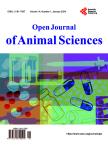Mitochondrial D-loop diversity of grasscutter (<i>Thryonomys swinderianus</i>Rodentia: Hystricomorpha) in Ghana
Mitochondrial D-loop diversity of grasscutter (<i>Thryonomys swinderianus</i>Rodentia: Hystricomorpha) in Ghana作者机构:Department of Animal Biology and Conservation Science Faculty of Science University of Ghana Legon Ghana Department of Animal Biology and Conservation Science Faculty of Science University of Ghana Legon Ghana Department of Animal Science School of Agriculture University of Ghana Legon Ghana Wildlife Research Center Kyoto University Kyoto Japan Wildlife Research Center Kyoto University Kyoto Japan
出 版 物:《Open Journal of Animal Sciences》 (动物科学期刊(英文))
年 卷 期:2013年第3卷第3期
页 面:145-153页
学科分类:1002[医学-临床医学] 100214[医学-肿瘤学] 10[医学]
主 题:Agro-Ecological Zones Rodent D-Loop Genetic Variation Thryonomys swinderianus
摘 要:Attempts are being made to domesticate the grasscutter (Thryonomys swinderianus) for commercial production in Sub-Saharan Africa to cater for the protein needs of the people and to satisfy the craving for bushmeat, thereby reducing habitat destruction through hunting. The objective of this study was to determine the genetic diversity of grasscutter populations in Ghana. DNA was extracted from roots of hair samples collected from 84 grasscutters from three agro-ecological zones in Ghana, namely Guinea Savanna (n = 17), Forest (n = 22), and Coastal Savanna (n = 45). Mitochondrial D-loop was sequenced and the diversity was determined across the zones. Out of 26 haplotypes found, 15 were obtained from Guinea Savanna, 7 from Forest and 13 from Coastal Savanna. Haplotype diversities were 0.978, 0.853 and 0.875 respectively for Guinea Savanna, Forest and Coastal Savanna zones. Analysis of molecular variance (AMOVA) revealed significant differentiation between Forest and Savanna populations (FST = 0.14, p 0.05). Network analysis indicated two clusters, one of which consisted of only Savanna haplotypes. Population neutrality tests showed that Forest and Coastal Savanna populations had been stable while the Guinea Savanna zone population had undergone an expansion (Fu’s FS = ‐7.132,



